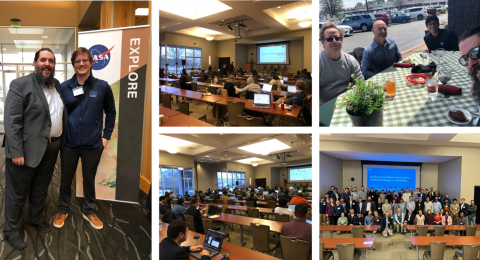
The NASA Science Mission Directorate (SMD) AI Workshop 2024 was recently held in Huntsville, Alabama and brought together a distinguished panel of more than 100 AI experts and scientists from outside and within the agency to delve into the future of Artificial Intelligence (AI) for space exploration and open science. Among the in-person attendees and presenters were several scientists and researchers from the Ames Space Biosciences Research Branch, the NASA Open Science Data Repository (OSDR), and AI for Life in Space (AI4LS). These include Dr. Sylvain Costes, the Branch Chief of Space Biosciences at NASA Ames and Project Manager for Space Biology Open Science (who also was on the workshop’s Steering Committee), Dr. Walter Alvarado (OSDR, AI4LS), Dr. James Casaletto (part of AI4LS, and lead developer of a soon-to-be-released Transform to Open Science Training AI curriculum for Space Biology), and Ryan Scott (Science Lead for the Ames Life Sciences Data Archive part of OSDR). Online was Dr. Lauren Sanders, Project Scientist for OSDR and Lead of AI4LS. Also, in-person as the invited keynote speaker to represent space life sciences and health, was Dr. Michael Moor of Stanford University. He gave a talk on his work developing Generalist Medical AI. Dr. Moor recently was also a speaker part of the Horizons in Biosciences and Informatics Seminar Series and is eager to collaborate on spaceflight tools and applications.
A highlight of the workshop was Dr. Alvarado's demonstration of a cutting-edge chatbot enabled by an SMD Large Language Model connected to the OSDR repository, where he is leading this effort. This tool is a leap towards making vast repositories of scientific data more accessible and interactive for knowledge extraction through AI technologies. In addition, a side workshop meeting was led by Dr. Alvarado with the SMD IMPACT team (Interagency Implementation and Advanced Concepts Team) to collaborate and learn from each other on how OSDR curates data, metadata, makes data maximally AI-ready for reuse, and updates on OSDR’s AI-based curation tools to scale up the volume of data coming into OSDR.
The workshop had Earth, Astrophysics, Biological, Health, Planetary, and Heliophysics-centric domains represented, so it was notable that several hours of the workshop examined OSDR, large language models for biological knowledge, and examined areas ripe for collaborations across NASA divisions of SMD to use foundation models to revolutionize our approach to space exploration, biology, and astronaut health monitoring. The “space applications for foundation models” breakout session discussed 3 use cases: the Earth/Moon/Mars Foundation Model; Space Radiation Foundation Model; and the Digital Twin Astronaut. The objective of the Earth/Moon/Mars Foundation model is to leverage Earth's existing models and data to better understand the Moon, Mars, and potentially other celestial bodies. These models aim to analyze the impact of space radiation, atmospheric content, and magnetic fields on various aspects of planetary science. The objective of the Space Radiation Foundation Model is to enhance the predictive capabilities for space radiation by expanding and integrating data into the RadLab database, utilizing a variety of sources including on-board International Space Station (ISS) dosimetry, heliophysics dosimetry data, and geomagnetic data. This effort is crucial for astronaut safety, mission planning, and developing effective radiation protection strategies. The objective of the Astronaut Digital Twin is to predict health outcomes under space conditions using extensive human data. This initiative stands to significantly advance the understanding and mitigation of health risks in space exploration.
These projects aim to enhance our predictive capabilities, monitor astronaut health more effectively, and help humans adapt and thrive while experiencing the hazard conditions of space environments. Workshop discussions also highlighted the place of federated learning (FL) as an AI approach in the future of space science and applications. FL in practice means datasets themselves aren’t transferred, only AI model weights. FL can be used to not only help in situ analytics in space to address data transfer and privacy challenges, but also can be leveraged by SMD on Earth across repositories and data lakes.

